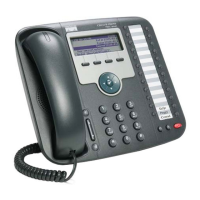4-34
Cisco Unified IP Phone 7931G Administration Guide for Cisco Unified Communications Manager 8.0 (SCCP and SIP)
OL-20798-01
Chapter 4 Configuring Settings on the Cisco Unified IP Phone
Device Configuration Menu
IP Addressing
Mode
Displays the IP addressing mode that is available on the
phone—IPv4 only, IPv6 only, or IPv4 and IPv6.
From Cisco Unified Communications
Manager Administration, choose
Device > Device Settings > Common
Device Configuration.
IP Preference
Mode Control
Indicates the IP address version that the phone uses during
signaling with Cisco Unified Communications Manager when
both IPv4 and IPv6 are both available on the phone.
The IP addressing mode preference is configured on Cisco
Unified Communications Manager Administration.
Displays one of the following options on the phone:
• IPv4—The dual-stack phone prefers to establish a
connection via an IPv4 address during a signaling event
• IPv6—The dual-stack phone prefers to establish a
connection via an IPv6 address during a signaling event.
From Cisco Unified Communications
Manager Administration, choose
Device > Device Settings > Common
Device Configuration.
Auto IP
Configuration
Displays whether the auto configurations is enabled or disabled
on the phone.
The Auto IP Configuration setting along with the DHCPv6
setting determine how the IP Phone obtains its IPv6 address and
other network settings. For more information on how these two
settings affect the network settings on the phone, see Table 4-5.
Note Use the “Allow Auto-Configuration for Phones” setting
in Cisco Unified Communications Manager
Administration.
From Cisco Unified Communications
Manager Administration, choose
Device > Device Settings > Common
Device Configuration.
IPv6 Load
Server
Used to optimize installation time for phone firmware upgrades
and offload the WAN by storing images locally, negating the
need to traverse the WAN link for each phone's upgrade.
You can set the Load Server to another TFTP server IP address
or name (other than the IPv6 TFTP Server 1 or IPv6 TFTP
Server 2) from which the phone firmware can be retrieved for
phone upgrades. When the Load Server option is set, the phone
contacts the designated server for the firmware upgrade.
Note The Load Server option allows you to specify an
alternate TFTP server for phone upgrades only. The
phone continues to use IPv6 TFTP Server 1 or IPv6
TFTP Server 2 to obtain configuration files. The Load
Server option does not provide management of the
process and of the files, such as file transfer,
compression, or deletion.
From Cisco Unified Communications
Manager Administration, choose Device
> Phone > Phone Configuration.
IPv6 Log Server Indicates the IP address and port of the remote logging machine
to which the phone sends log messages. These log messages help
in debugging the peer to peer image distribution feature.
Note The remote logging setting does not affect the sharing
log messages sent to the phone log.
From Cisco Unified Communications
Manager Administration, choose
Device > Phone > Phone
Configuration.
Table 4-20 Network Configuration Menu Options (continued)
Option Description To Change

